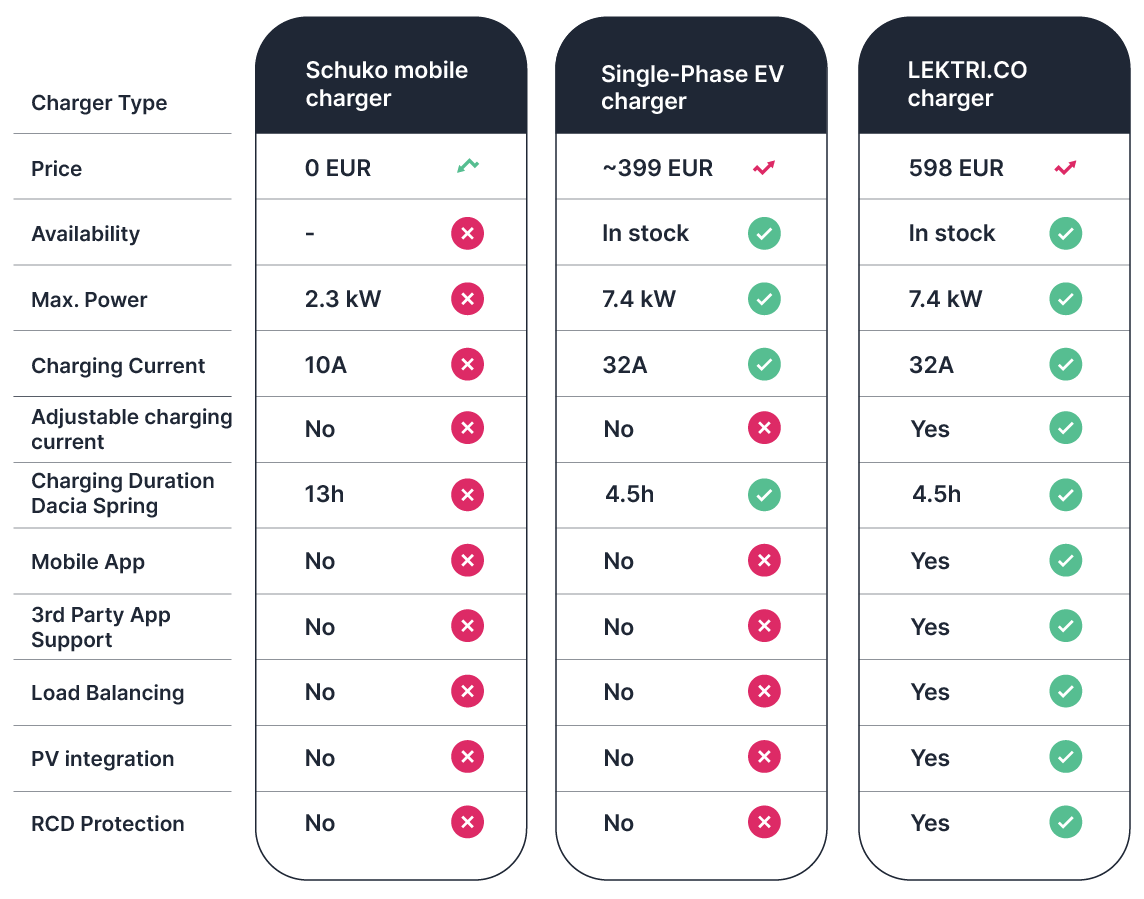The Dacia Spring model is already known to most people: it is an electric car sold under the Dacia brand and manufactured in China. In addition to the much lower maintenance and running costs of electric cars compared to those with internal combustion engines, the purchase price of the Dacia Spring is very attractive when we also consider subsidies in most European countries. We have already done the presentations on the occasion of other materials, so let's see how we can charge this car at home, at work, or in other public locations.
The fastest way to charge the Dacia Spring is at direct current (DC) fast charging stations, but these can sometimes be too fast when the car spends 8 hours in the parking lot at work. Moreover, it is also the most expensive option. The car can charge at such a station with a power of up to 34 kW. The connector used for this type of charging is CCS2.

Charging at your destination at alternating current (AC) stations is one of the easiest ways to charge any electric car. Whether we're charging at home, overnight, whether we're charging at the office, while the car is parked, or in public parking lots while we deal with other things. Using charging a station with a Type2 connector, we can fully charge the car's battery in an interval between 4-13h.
Because the charging power of electric cars at alternating current stations is limited by the OBC (on board charger), and because the Dacia Spring has a single-phase OBC limited to 6.6 kW, we will only discuss single-phase chargers.

So let's see which chargers are suitable for this type of "slow" charging and the positives and negatives of each.
The most accessible and handy charger is the portable one, received with the purchase of the car, being practically free. This charger plugs into a normal, Schuko outlet and can charge your car from 0-100% in about 13 hours. Its maximum power is 2.3 kW, and the amperage cannot be adjusted, being set to 10A.


Another 7.4 kW single-phase charger is among the most affordable on the market. This needs a single-phase power supply and connects to the main fuse panel, requiring a dedicated power supply and its own type B or EV differential protection fuse, not having this built-in protection. This safety device drastically increases the cost of installation. The maximum charging power is 7.4 kW; even with this charger, the amperage cannot be adjusted, being set at 32A. The station has no wireless connectivity, mobile application, or load-balancing system. So you have to make sure you have the 7.4 kW available to avoid tripping the main fuse.
The subject of required fuses has been detailed in the article Why do we need electrical protections in charging stations?


The LEKTRI.CO 1P7K charging station also needs a dedicated power supply protected by a differential protection fuse, type A, already having direct current protection integrated. It can be mounted on the wall of the house/garage or on a metal pole. Unlike the previously listed variants, this station allows the adjustment of the amperage (and therefore the charging power), has Wi-Fi connectivity, and can be controlled from the mobile application.
This charging station can be connected to any single-phase supply as it can automatically limit the maximum charging power, unlike the other two chargers tested.


In the following table we compare the main functions of the 3 chargers:

The benefit of charging the car battery using the energy from the photovoltaic panels primarily represents the financial savings achieved. Let’s consider the price of used electricity being 0.5 EUR/kWh and the price of the injected electricity being 0.25 EUR/kWh. If the photovoltaic installation produces 1 MWh of electricity that we inject into the network, we will receive approximately 250 EUR (depending on the tariff set by the supplier). Using that 1 MWh from the network will pay 500 EUR. Therefore, each MWh loaded with photovoltaic energy brings a saving of 250 EUR. Considering an annual journey of 20,000 km with an average consumption of 15 kWh/100 km would mean total consumption of 3 MWh, which if it came from the photovoltaic system would bring savings of 750 EUR annually. The LEKTRI.CO 1P7K charger pays for itself through savings from solar charging.
Of course, the Schuko mobile charger and the second tested charging station can also be used for solar charging, but the "adjustment" is made manually, starting and stopping the charging based on solar production. Instead, the LEKTRI.CO 1P7K charger automatically reduces the charging power when the photovoltaic system does not produce enough energy.

In the end, each of these 3 tested chargers fulfills its purpose, which is to charge the car battery, but when choosing the most suitable charger for our needs, specific functions such as connectivity and the availability of the mobile application to control the charger or load balancing must be considered. Charging with energy from the solar system is also an important feature in reducing costs and CO2 emissions. In order to have the desired flexibility in choosing the charging parameters, it is advisable to choose a smart charger connected to the internet.
And last but not least, we recommend paying more attention to safety and protection elements such as residual current monitoring systems, overload, and overtemperature protection.
